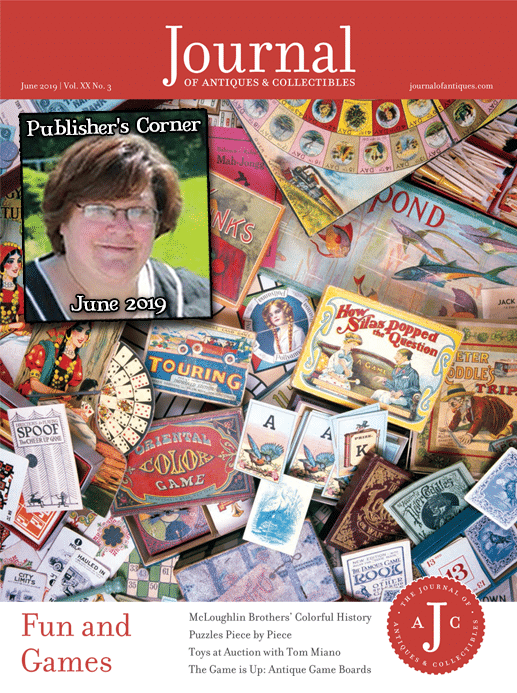Collecting Fun & Games
by Maxine Carter-Lome
Every child grows up with a favorite game or toy that carries with it precious memories of bygone days and friends from the past, which is why this month’s topic is particularly nostalgic and fun to consider.
Toys and games from particularly the 1930s to 1980s are now cropping up at flea markets, antique shops, on eBay and at specialty auctions, realizing unbelievable sales for some inexpensive items that at the time many parents considered “disposable;” designed to be played with until replaced by something new. Who among us at the time thought to buy a children’s game or toy, comic book or baseball cards and not let a child play with it? Collectors. And their gamble is paying off nicely, especially when it comes to baseball cards and comics.
Thanks to mothers across the country who gave away toys and dolls and tossed baseball cards and comics in a vain attempt to manage the clutter, far fewer examples exist today than were originally produced, and much of what is left shows the wear and tear of age and use. In this market, condition and rarity dominate auction records, and those with the forethought to buy, preserve, and save for a future resale market are seeing exponential returns on their investment.
A December 2018 Good Housekeeping article covered the “Top 40 Most Valuable Toys From Your Childhood,” providing best example values from auctions and internet sales, including: a 1978 Luke Skywalker Action Figure in its as-new box which fetched $25,000 at a 2015 Sotheby’s auction; the original Monopoly game made in the 1930s and owned by the inventor Charles Darrow which sold for $146,500 at Sotheby’s in 2011; a 1938 edition of Action Comics #1 that introduced the world to Superman which sold for $3.2 million on eBay in 2014; and a 1959 first edition Barbie doll which sold for $23,000. Other items that made the list include specific Beanie Baby toys, early Lionel trains, Game Boys, the first U.S. edition of Harry Potter and the Sorcerer’s Stone, vintage Colorforms, Happy Meal toys, and Pokemon cards. Many of these items were purchased at the time for the price of a child’s saved-up allowance, their only value in the use and enjoyment of its intended purpose.
That is no longer the case today, and manufacturers know and count on it, methodically building a demand-based collectors market by releasing limited edition, special anniversary, and regional versions of their products. Franchise-based action figures, Beanie Babies, Matchbox cars, Pokemon cards, and Legos are all examples of products that rolled out with this express intent. Tom Miano, recently named director of Potter & Potter Auctions’ newly-created Toys/Pop Culture Department, shares his perspective on the toy market at auction today in his interview with Managing Editor Judy Gonyeau. His advice to toy and pop culture collectors? “Buy what makes you happy. Smiling is the foundation for any [toy] collection.”
While it is hard to know what to collect and when to get in on the next trend, one place to look for inspiration is The National Toy Hall of Fame® at The Strong, in Rochester, New York. Every year since 1998, toys that have stood the test of time are inducted into The National Toy Hall of Fame. To date, 68 toys have had that honor, most recently Magic 8 Ball, Pinball, and Uno.
Long before games and toys were manufactured, cultures around the world created pastime activities from objects at hand. Games such as Hounds and Jackals, and knucklebones (the precursor to Jacks), date back to ancient Egypt, and Backgammon to ancient Mesopotamia over 5,000 years ago. Many of the lawn, dice, and board games we grew up with have roots that are thousands of years old. While the rules may have been different and the game pieces made from everyday objects, the intent was the same from culture to culture, century to century – to entertain and amuse. You can learn more about the history and collectability of some of your favorite outdoor games, and how game boards of the 19th and early 20th century are now viewed with new purpose as folk art, as you will read in Melody Amsel-Arieli’s article.
When it came to producing and mass marketing children’s books, games, and toys for a turn-of-century America, McLoughlin Brothers of New York dominated the market. The company has a rich and colorful history, especially in print publishing. This makes them an interesting company to know more about given the current rise in the collector status of early examples of McLoughlin Bros.’ children’s games, puzzles, paintings, and books.
What’s more fun—for children and adults—than a bicycle ride? A favorite pastime for more than a century and a half, bicycles have come in all shapes, sizes, colors, and designs. Someone who knows a lot about that is the focus of this month’s Great Collections column, Lorne Shields, an enthusiastic and knowledgeable collector of cycliana – all things bicycle-related.
While finding my childhood toys and games where I shop and while doing internet search for antiques and collectibles reminds me of my age, it is also a reminder that well-built and designed children’s toys can last a lifetime, survive age and use, to be appreciated and valued anew by a new generation of children and collectors of fun and games.
-
- Assign a menu in Theme Options > Menus WooCommerce not Found





Related posts: